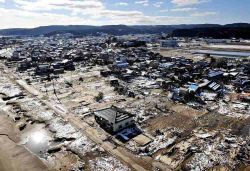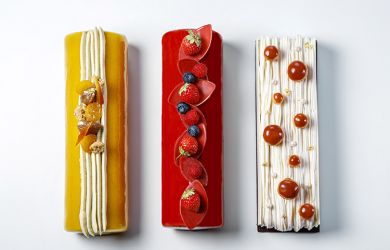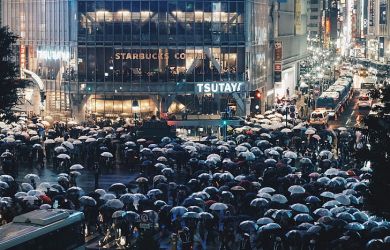
December 9, 2005
City of Sand
From crowded markets to placid mosques, Cairo’s attractions are legion
By Metropolis
Originally published on metropolis.co.jp on December 2005

Photos by Stephen Mansfield
It’s not surprising, given Cairo’s pre-eminence in the Arab world and its aura of mystique, to find a whole nation ready to clamor for a few square meters of its power and divinity. Cairo’s masses are its lifeblood, a high-spirited people who make the city tick and hold its destitute buildings and communities together with commendable dignity.
Living conditions were a little better than when I resided in this sandy city during the early ’80s. But only just. “God help them,” the Arab family I stayed with used to exclaim upon hearing that another cousin or aunt would be moving into a neighbor’s house. “Even now you can faint in their apartment and not fall over!” Good humor has always been the saving grace of this city. These days it is indispensable.
Urban migration is a powerful force in Egypt, requiring new arrivals to seek out some extraordinary forms of accommodation. Rowboats and fellucas, the lateen-sailed craft common to the Nile, crowd the inner city banks of the river, doubling as fishing and houseboats, with whole families sleeping among the nets, tackle and pungent unsold remains of the day’s catch. Others, luckier, take to the rooftops of their friends’ or families’ apartments. Over half a million people live among the Ayyubid and Fattimid mausoleums and family tombs of the Northern and Southern cemeteries, an area better known as the City of the Dead. Visitors to Cairo may be shocked by the conditions, but residents face the degeneration of their 1,000-year old capital with a resigned smile and a gesture that signifies “Maleesh!” or “What does it matter? It can’t be helped!”

Even for the native, Cairo’s urban geography can seem bewildering at times. Two outstanding, and quite different, views that help to make some sense of the city can be had from the Gezira Tower and the old Citadel. From the first, a modern aerial construction replete with restaurant and bar, commanding views of a modern cosmopolitan city stretch impressively below. To the south of the tower, just visible, the great Pyramids of Giza stew and smolder like stock cubes in a cauldron of petrochemical haze, all the buildings between covered in a film of sand. For a more medieval view, the Citadel—one of the great mosques and minarets—is unsurpassed. Saladine’s old fortifications also house the impressive 19th-century mosque of Mohammad Ali.
Cairo’s old quarter, near the university of Al-Azhar, is the city’s busiest, most traditional and most timeless district—a place of spice stalls, instrument makers, tailors, carpet factories, herbalists, purveyors of gold, perfume and spurious “Pharaonic” ornaments and knickknacks. Cairo, more than any other spot on earth, is a city of mosques. There are an estimated 2,000 of them. Mosques are good places to duck into when you have had enough of the city’s high voltage crowds. There are few quiet parks to be found within modern Cairo; mosques substitute as the lungs for this great, clamorous city.
A personal favorite has always been the Ibn Tulun. Largest among congregational mosques and Cairo’s second oldest, it was once endowed with rich and privileged benefactors. Today it is disregarded by most Cairenes, except for holy Fridays and, apart from the odd coachload of tourists, it remains blissfully quiet and decanted of people. An adjoining wall from the outer courtyard leads to the Geyer Anderson Museum, which should not be missed on any account. Anderson was a major in the British army in the ’20s, and while serving in Egypt avidly collected and stocked his 18th-century merchant home with antiques and works of art, all of which he bequeathed to the country along with some wise conservation provisos. The house and its marvelous contents evoke the classic colonial ambiguities: the isolated privilege of such people but also an exquisite taste, refinement and genuine affection for his adopted country.
Find an empty table in Al-Fishawi, a coffeehouse in the bustling Khan-el-Khalili bazaar district, not far from the Ibn Tulun mosque on the vibrant fringes of the old quarter. Sitting here, one of the few cafés that welcomes women customers on an equal basis with men, you will begin to appreciate the charm of Cairo and the strong appeal that it has for many Egyptians, including its intelligentsia who come to discuss literature and politics. This teeming quarter at the edge of the Old City, stretching from the ramparts of Saladin’s Citadel and bastide in the east, boasts some of the most magnificent religious and civic institutions in the city, making the neighborhood the world’s richest concentration of medieval Muslim architecture.
JAL and Egypt Air are the obvious choices for flights to Cairo. City buses are terribly overcrowded; taxi drivers can be reckless. There is also a subway system that was completed in the ’90s. Although security is always an issue, attacks on tourist areas and locations have tended to target resort hotels or the archeological sights in middle and southern Egypt. All the big hotel chains—Hilton, Marriott, Four Seasons—operate in Cairo, but for cheaper deals check out www.georgia-discounthotels.com. The Khan el Khalili Restaurant, in the old bazaar district of the same name, is unmatched. www.cairodining.com
Lonely Planet and Insight guides to Cairo are handy, as is the Periplus map of the city. The Cairo settings of Nobel Prize-winning Egyptian writer Naguib Mahfouz are a wonder. Cairo: The City Victorious, by Max Rodenbeck, is a fine, richly layered chronicle of the city.
[geo_mashup_map]

